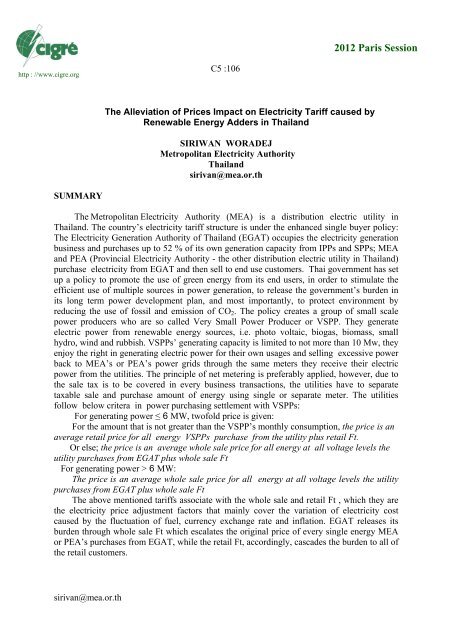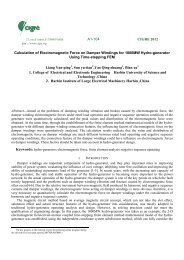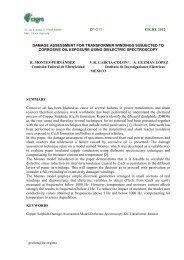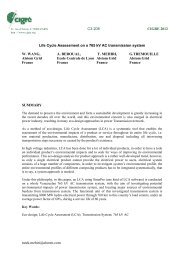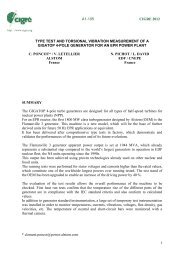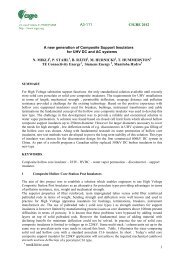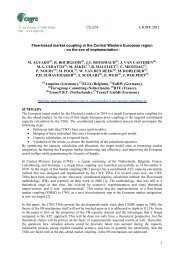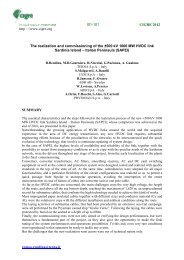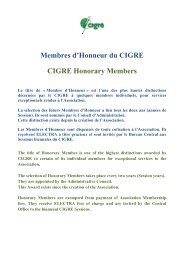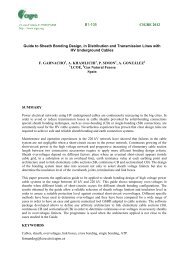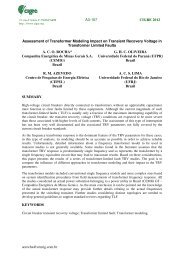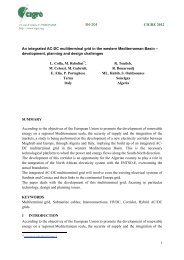2012 Paris Session - Cigre
2012 Paris Session - Cigre
2012 Paris Session - Cigre
You also want an ePaper? Increase the reach of your titles
YUMPU automatically turns print PDFs into web optimized ePapers that Google loves.
<strong>2012</strong> <strong>Paris</strong> <strong>Session</strong><br />
http : //www.cigre.org<br />
C5 :106<br />
The Alleviation of Prices Impact on Electricity Tariff caused by<br />
Renewable Energy Adders in Thailand<br />
SIRIWAN WORADEJ<br />
Metropolitan Electricity Authority<br />
Thailand<br />
sirivan@mea.or.th<br />
SUMMARY<br />
The Metropolitan Electricity Authority (MEA) is a distribution electric utility in<br />
Thailand. The country’s electricity tariff structure is under the enhanced single buyer policy:<br />
The Electricity Generation Authority of Thailand (EGAT) occupies the electricity generation<br />
business and purchases up to 52 % of its own generation capacity from IPPs and SPPs; MEA<br />
and PEA (Provincial Electricity Authority - the other distribution electric utility in Thailand)<br />
purchase electricity from EGAT and then sell to end use customers. Thai government has set<br />
up a policy to promote the use of green energy from its end users, in order to stimulate the<br />
efficient use of multiple sources in power generation, to release the government’s burden in<br />
its long term power development plan, and most importantly, to protect environment by<br />
reducing the use of fossil and emission of CO 2 . The policy creates a group of small scale<br />
power producers who are so called Very Small Power Producer or VSPP. They generate<br />
electric power from renewable energy sources, i.e. photo voltaic, biogas, biomass, small<br />
hydro, wind and rubbish. VSPPs’ generating capacity is limited to not more than 10 Mw, they<br />
enjoy the right in generating electric power for their own usages and selling excessive power<br />
back to MEA’s or PEA’s power grids through the same meters they receive their electric<br />
power from the utilities. The principle of net metering is preferably applied, however, due to<br />
the sale tax is to be covered in every business transactions, the utilities have to separate<br />
taxable sale and purchase amount of energy using single or separate meter. The utilities<br />
follow below critera in power purchasing settlement with VSPPs:<br />
For generating power ≤ 6 MW, twofold price is given:<br />
For the amount that is not greater than the VSPP’s monthly consumption, the price is an<br />
average retail price for all energy VSPPs purchase from the utility plus retail Ft.<br />
Or else; the price is an average whole sale price for all energy at all voltage levels the<br />
utility purchases from EGAT plus whole sale Ft<br />
For generating power > 6 MW:<br />
The price is an average whole sale price for all energy at all voltage levels the utility<br />
purchases from EGAT plus whole sale Ft<br />
The above mentioned tariffs associate with the whole sale and retail Ft , which they are<br />
the electricity price adjustment factors that mainly cover the variation of electricity cost<br />
caused by the fluctuation of fuel, currency exchange rate and inflation. EGAT releases its<br />
burden through whole sale Ft which escalates the original price of every single energy MEA<br />
or PEA’s purchases from EGAT, while the retail Ft, accordingly, cascades the burden to all of<br />
the retail customers.<br />
sirivan@mea.or.th
The introduction of VSPPs has caused some burden to electricity end users owing to the<br />
price adders which is a kind of incentive used to promote the green energy, e.g. the adder for<br />
photo voltaic is 8 Baht/ kWh, on the other hand, these adders impact the retail price as they<br />
worsen the whole sale Ft, retail Ft and then upturn the retail price charged to all end use<br />
customers. The rocketed sky-high retail Ft situation in Thailand once slow down the<br />
promotion of the use of green energy as it deems unfair to other end users. This paper<br />
proposes an alternative to deal with the problem by tracking the root causes of Ft contributed<br />
by various groups of consumers. A large portion of the price adders would be used to<br />
stimulate the change of behavior to those who contaminate while smaller portion or none<br />
would be distributed among those who preserve. The paper will fully exhaust the class peak<br />
responsibility method to render it an efficient tool to promote the green policy, encouraging<br />
more green generators, and more importanty, to bring the causes of high Ft down.<br />
KEYWORDS<br />
Adder, Class Peak Responsibility (CPR), Ft, Feed in Tariff<br />
sirivan@mea.or.th
1. Electricity Structure and Tariff in Thailand<br />
Electricity Structure: Thailand’s electricity supply industry is under the enhanced single<br />
buyer model (ESB) as shown in Figure 1. The state generation system owns by EGAT as well<br />
as it is the sole electricity buyer from private generators. EGAT’s own power generating<br />
capacity presently comes down to approximately 45% (as of September 2011) of the total<br />
capacity of the country. The private<br />
generators in Thailand which contribute the<br />
rest can be classified in 3 categories:<br />
Independent Power Producers (IPPs), Small<br />
Power Producers (SPPs) and Very Small<br />
Power Producers (VSPPs). In addition to the<br />
electricity generation and buyer, EGAT is<br />
also responsible for the country’s<br />
transmission system as well as being the<br />
system operator. Besides EGAT, there are 2<br />
Figure 1. Enhanced Single Buyer Model<br />
geographical separated distribution utilities in<br />
Thailand: the Metropolitan Electricity<br />
Authority (MEA) and the Provincial Electricity Authority (PEA). MEA is responsible for<br />
power distribution, sales and provision of electric energy services in Bangkok Metropolis, and<br />
other 2 adjacent provinces: Nonthaburi and Samut Prakran while PEA serves the rest of the<br />
country.<br />
Electricity Tariff : Thailand’s electricity tariff is uniformly applied acorss the country, it<br />
comprise 3 parts; Base tariff, Fuel adjustment mechanism and Value Added Tax. The first<br />
part, the Base Tariff reflects the marginal cost of the utilities to construct power plants,<br />
transmission lines, distribution lines including fuels. It is certain that assumptions had to be<br />
made pertaining to fuel prices, inflation and exchange rates before the Base Tariff could be set<br />
up. The Base Tariff is further divided into 8 categories according to ones’ ‘Load Pattern’ –<br />
the daily load consumption characteristic of certain group of customers measured in MWh.<br />
The second part , the Fuel Adjustment Mechanism (Ft) is activated once the fuel prices,<br />
inflation and exchange rates fall off from the assumptions. This happens almost every month<br />
however the Ft is preferably adjusted every 4 months to avoid the fluctuation of cost of<br />
production, the Ft is therefore deemed to be an unfavourable part that upturn the electricity<br />
price. The cause of high Ft is not only the higher fuel cost in power generation by EGAT,<br />
private generators (IPPs and SPPs) and neighboring countries who import electric power to<br />
Thailand, other government policy such as the Power Development Fund, renewable energy<br />
adder, etc are from time to time place burden on Ft. Finally, the Value Added Tax, - it levies<br />
7% of sale tax on total electricity expense including Ft.<br />
2. Renewable Energy Promotion<br />
To promote efficient use of resources within the country, reduce dependency on electricity<br />
generation using commercial fuels, which will help decrease expenditure and also alleviate<br />
the government’s investment burden in electricity generation and distribution systems.<br />
Therefore, in year 2001, The National Energy Policy Council (NEPC), chaired by the Prime<br />
Minister, passed the resolution to allow the distribution electricity utility - MEA and PEA to<br />
purchase electricity from Very Small Power Producers(VSPPs) whose maximum generating<br />
capacity is limited to 1 MW and to urge the utility to produce electricity from renewable<br />
energy such as wind, solar energy, mini or micro-hydro, sea or ocean waves, geothermal<br />
sirivan@mea.or.th
energy and biogas ,etc. Later in year 2006, the maximum generating capacity of VSPPs has<br />
been raised to 10 MW.<br />
In order to reach the target, the Thai government used several campaigns such as the tax<br />
exemption for investors on renewable business issued by Board of Investment; venture capital<br />
fund for ESCO, etc to encourage investors. Among these incentives, Feed-in Premium<br />
commonly known as “Adder” is the most successful measure which strongly and effectively<br />
boosts the renewable market in Thailand, especially solar energy.<br />
As the cost of electricity generated by renewable energy is higher than that of conventional<br />
energy, it is no way to commercialize renewable energy without an “adder” In year 2009, the<br />
EPPO (Energy Policy and Planning Office) therefore developed a renewable energy adder<br />
policy so called “feed-in premium” in an effort to reduce this gap. The adder rate is different<br />
from technology to technology and its installed capacity. The adder table is as follows.<br />
Fuel<br />
Biomass/Biogas<br />
- Installed capacity 1 MW<br />
Waste(community waste, not hazardous<br />
industrial waste and inorganic waste)<br />
- AD&LFG<br />
- Thermal Process<br />
Wind Power<br />
- Installed capacity 50 MW<br />
Mini and micro hydropower<br />
- Installed capacity 50-200 kW<br />
- Installed capacity < 50 MW<br />
Table 1 : Adder rates by technology<br />
Adder(Baht/kWh)<br />
VSPP SPP<br />
0.50<br />
0.30<br />
2.50<br />
3.50<br />
4.50<br />
3.50<br />
Special<br />
adder*<br />
(Baht/kWh)<br />
Bidding 1.00<br />
1.00<br />
2.50<br />
3.50<br />
1.00<br />
1.00<br />
3.50 1.50<br />
1.50<br />
Supporting<br />
period<br />
(Year)<br />
0.80 - 1.00<br />
7<br />
1.50<br />
1.00<br />
7<br />
Solar power 8.00 8.00 1.50 10<br />
One drawback of the “feed-in premium” after the policy had been successfully come<br />
to effect was that – The amount of adder of renewable energy which was mostly the Solar<br />
Power was so large that when it was converted to Ft, it made the Ft exceeded 0.08 THB/kWh<br />
which was the maximum amount allowed by the policy of the NEPC (National Energy Policy<br />
Committee). NEPC then passed a resolution on the 28 th June 2010 to temporarily cease the<br />
new projects and reduce the adder from 8 THB/kWh to 6.50 THB/kWh for those under<br />
approval ones. The second government issues was the trend to develop a specific Feed-in<br />
tariff for rooftop PV and top up the regular tariffs,<br />
7<br />
7<br />
7<br />
7<br />
10<br />
10<br />
3. Impact on Ft Caused by Adder<br />
The Adder is the major cause of the upturn in Ft. The Ft value partly bases on the amount<br />
of energy generated by renewable sources. As of October 2011, it is evident that the<br />
renewable sources are 2,223.07 MW higher than that of 5,900 MW planed in the<br />
government’s 15-Year Renewable Energy Development Plan (REDP). The excessive<br />
renewable sources then impact significantly on Ft. The average affect to Ft is between 0.059<br />
to 0.201 per kWh while the maximum Ft will occur in year <strong>2012</strong> to 2016, when maximum<br />
power is scheduled to feed into a distribution system.<br />
sirivan@mea.or.th
Figure 2 : Status of renewable energy<br />
Figure 3 : The amount of Adder Value<br />
Figure 2 shows the status of renewable energy in Thailand (as of October 2011), the<br />
renewable energy shown is represented by its adder only. The trend of renewable energy<br />
growth in view of its adder is quite rapid, while the real impact of the adder to Ft in term of<br />
THB/kWh is shown in Figure 3<br />
We can form a formula to calculate the total amount of impact on Ft causes by the adders<br />
like this: Total Impact on Ft (THB/kWh (All Thailand) ) equal Total amount of Adder (Total) divided<br />
by Total Energy Consumption (PEA, MEA and EGAT direct customers)<br />
Or<br />
Adder (Total)<br />
Total Impact on Ft =<br />
Total kWh (PEA, MEA and EGAT direct customers)<br />
Adder that passes through to Ft will impact all end users, sence, he or she,no matter what<br />
category, has to pay higher electricity bill with such adder. However, electric tariffs have been<br />
designed to reflect the principle of marginal cost according to Class Peak Responsibility<br />
(CPR) of each category adjudged by each load characteristic. For example,any the business or<br />
industrial customer group is more likely to take more burden the utility with the construction<br />
of new power plant, transmission or distribution system, than the residential or small business<br />
customer group.<br />
Figure 4 shows system<br />
load characteristics of<br />
each category, It is clear<br />
that load on electricity<br />
consumption of Thai<br />
System (as of October<br />
2011) is 11,111 MW. For<br />
residential service<br />
(consumption less than<br />
150 kWh per month)<br />
contributes the system<br />
peak at 2,877.14 MW or<br />
4.81% of system profile<br />
and residential service<br />
Figure 4 : System Load Characteristics<br />
(consumption more than 150 kWh per month) contributes the system peak at 3,741.36 MW<br />
or 9.22% of system profile, small general service contributes the system peak at 3,228.44<br />
MW or 13.49% of system profile , medium general service contributes the system peak at<br />
4,744.66 MW or 19.09% of system profile, large general service contributes the system peak<br />
at 9,876.84 MW or 41.22% of system profile, specific business service contributes the<br />
system peak at 869.05 MW or 2.80% of system profile, non- profit service contributes the<br />
system peak at 2,101.32 MW or 8.70% of system profile and finally, Agricultural service<br />
contributes the system peak at 536.08 MW or 0.67% of system profile.<br />
sirivan@mea.or.th
Therefore, in the light of the “peak” each category burdens the utility, it is fair if NEPC<br />
would decide to pass through the adder by means of Ft to all categories to reflect these<br />
burden. The adder should not be simply the burden of all the customers equally. In other<br />
word, it should be dealt with as the cost items in the base tariff by considering the load<br />
characteristic of each customer group .The more burden or “cost” the category burdens the<br />
system, the more it should bare its portion of responsibility. Taking into account the principle<br />
of burden on system or CRP, we can simply calculate “the portion of responsibility” which in<br />
turn reflects in Ft for each category. The detailed calculation based on system load<br />
characteristics curve in year 2011 is shown in Table 2.<br />
Table 2 Portion of responsibility to support renewable sources versus system peak contribution<br />
Tariff Category<br />
Residential Service<br />
(consumption less than 150 kWh per<br />
month)<br />
Residential Service<br />
(consumption more than 150 kWh<br />
per month)<br />
Peak<br />
Contribution<br />
(%)<br />
4.81<br />
Renewable Energy<br />
Adder<br />
(As of year 2011)<br />
(MBaht)<br />
Portion of<br />
responsibility<br />
(MBaht)<br />
64.97<br />
9.22 124.71<br />
Small General Service 13.49 182.35<br />
Medium General Service 19.09 1,352.09<br />
258.09<br />
Large General Service 41.22 557.38<br />
Specific Business Service 2.80 37.90<br />
Non-Profit Service 8.70 117.68<br />
Agricultural Service 0.67 8.99<br />
Total 100 1,352.09 1,352.09<br />
4. Conclusion<br />
The renewable energy incentive programs in Thailand have come to an amazing result,<br />
for the number of installed renewable sources as of the year 2011, it is already 37% higher<br />
than its original target stated in REDP and there are still a lot to come. The majority that<br />
enrolled in the program is the solar project which by far 5 times exceed the target, the second<br />
and the third runner up are wind energy and waste and biogas respectively. However, minihydro<br />
and biomass are lower than the 15-years REDP target.<br />
The key success factor is the incentive adders that bring in more and more renewable<br />
investors. The incentive adders are converted into retail Ft and passed through to all the<br />
customers equally, nevertheless, this causes problem as it upturns the Ft to exceed 0.08<br />
THB/kWh which is the maximum amount allowed by the policy of the NEPC. The<br />
sirivan@mea.or.th
government ceases some solar projects and renegotiate with new comers to lower the original<br />
adders and may adversely change the adder policy to feed in tariff in the future. These<br />
remedies cannot be a long term solutions because firstly, Thailand is desperate for renewable<br />
energy sources through adder policy, secondly, when the adders have been replaced with feed<br />
in tariff and top the regular tariffs, this not only distorts the marginal cost pricing structure, it<br />
also directly impact the cost of distribution utility which in turn recover from the high retail<br />
tariff.<br />
In this case, a CRP principle can be well applied to the situation: It is not fair to pass<br />
through the renewable adders to all end users equally, rather it should follow the rule of<br />
responsibility by considering the electric consumption of some categories, e.g. residential<br />
service who create only 4.81% of the system burden (cost of construction new power plants,<br />
new transmission lines, etc.), while the large general service create 41.22%. In this regard, the<br />
large general service should bare more responsibility to support the need of renewable sources<br />
than residential service. Other categories can follow the same rule as stated in table 1<br />
Finally, if a feed in tariff does exist to allow renewable energy has its own retail pricing and<br />
thus top the other categories’ retail price, care should be given to follow the CPR in retail<br />
pricing so that the marginal cost pricing principle will not be distorted. Now come to the<br />
question: If this is the case, should we cease the renewable promotion program since it<br />
impacts retail pricing.<br />
BIBLIOGRAPHY<br />
[1] Regulations for the Purchase of Power from Very Small Power Producers<br />
(December 1992 pages 1-7)<br />
[2] Data in Renewable installed <br />
[3] Data in the amount of Adder <br />
[4] Load Characteristic<br />
[5] V,Lorgirachunkun , “Training in Design Electric Tariff” , October 2008<br />
sirivan@mea.or.th


